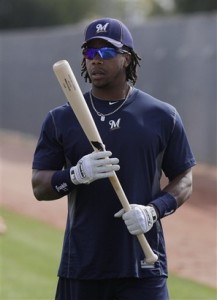Not sure what kind of bat you should choose? There are several major types of baseball bats on the market and, believe it or not, the difference in the technology between them could mean the difference between striking out or knocking it out of the park. Choosing between an aluminum or composite bat is already difficult and that’s without picking between the many Easton, Louisville, or Demarini bats. Here’s what you need to know.
Aluminum Bats
Aluminum bats were introduced in 1974. The aluminum bat was an economical answer to the rising costs of wood and the cost of replacing these tired old bats that were constantly breaking during the season.
The first aluminum baseball bats were heavy, however, and didn’t perform that much differently than their wooden counterparts.
However, over time, alloys enabled single-walled designs that outperformed wood bats.
In 1986, there were concerns about the dramatic increase in the performance of aluminum bats. The NCAA imposed a lower limit on the total weight of the bat that had to be used in games. This effectively limited the technology (and potential) of aluminum.
Now, this wasn’t a performance standard, but rather a construction-based restriction. Aluminum could be made much lighter than wood due to the fact that the metal could be hollowed out. This meant a faster swing and better bat control.
Ultimately, the NCAA’s restriction caused bat performance to plummet.
In the 1990s, there were several governing bodies and manufacturers that were mulling over the regulations imposed on bat performance. After the 1998 season, the NCAA finally adopted the BESR standard, which established a ball exit speed ratio. This became the new standard to regulate the performance of aluminum and the new composite bats on the market.
Finally, in 2011, the BBCOR standard was put in place. This replaced the old standard with a new one that required non-wood bats to produce batted ball speeds which were no greater (faster) than wooden bats. In other words, the potential speed of the ball, when hit with an aluminum bat, could not exceed the potential when hit with a traditional wooden bat.
Wooden Bats
While aluminum bats were, for a long time, one of the most popular types of bats, the first bats were actually made of wood in 1846. In the beginning, baseball players were responsible for choosing their own bats. There was no restriction on length, size, or width.
Through experimentation, many ball players found that wagon tongue wood was the best for making baseball bats. And, they discovered that round bats were superior to any other shape.
It wasn’t until 1859 that the Professional national Association of Baseball Players Governing Committee voted for a limitation on bat size in league games.
They specified that bats be no larger than 2 and ½ inches in diameter. They could be of any length, however.
Over time, the restrictions grew.
Composite Bats
Composite bats have been around for a while, but their popularity has waxed and waned. Now, we’re seeing a huge resurgence in bats like the DeMarini CF8 BBCOR. It wasn’t until recently that composite bats could seriously compete with aluminum bats, even though composited were available as far back as 1985.
These early bats were advertised as having the performance of wood, but they couldn’t perform as well as aluminum, so they never really took off as expected.
It wasn’t until 2000 that things changed.
In 2001, the famous Louisville Slugger Genesis all-composite slow-pitch softball bat took the number one spot in performance at the 2001 Bat Wars.
There was only one problem: durability. The Genesis bats were notorious for breaking after about 50 hits.
The second generation models had a slightly thicker wall and were more durable, though this caused a drop in performance. In 2002, Miken introduced a gray Velocit-E Ultra. It became the highest performing commercially-available softball bat.
While many college and youth players prefer aluminum, composite bats do outperform aluminum in several key areas. Most of the tests showing performance for bats use a high-speed pitching test.
The bat is held in place, 6 inches from the knob end of the handle, by a clamp. The clamp is free to rotate around a fixed pivot point. The softball is then shot from a compressed air cannon at 110mph toward the bat.
The ball speed is measured using light traps before, and after, it hits the bat.
Then, an equation is used to calculate the conservation of momentum which will take into account the impact and location and moment-of-inertia of the bat. All of this is used to predict the batted ball speed, which is predictive of performance.
Composite bats consistently show batted ball speeds between 96-100 mph, compared to the best double-walled aluminum bats clocking in at about the same speeds. Wooden bats produce batted ball speeds of between 88-90 mph.
But, single-walled aluminum bats, bats preferred by most players for their weight, only clock in at between 90 and 96mph.
The best composite bats can achieve batted ball speeds over 105 mph. In fact, the range of performance for composite bats is huge compared to aluminum.
And, this is why many ball players should eventually wake up to the idea of composite as the new aluminum.
Jeff Wise graduated from Middle Tennessee State University in 1998. Wise, with more than 14 years experience playing baseball has also privately coached players. Wise is an entrepreneur and reviews all the latest baseball equipment. He currently resides in the Nashville, Tennessee area.

